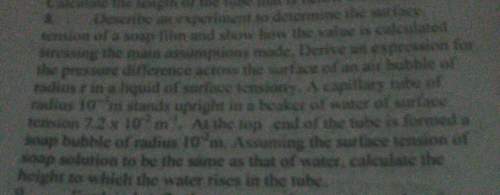
Physics, 24.01.2020 00:31 Victoriag2626
The motion of roller coasters depends upon the conversion of potential and kinetic energy. a 100-kg car starts from rest at the top of a hill with a height of 50 m. which of the following is this car's kinetic energy at the bottom of the hill?

Answers: 3


Another question on Physics

Physics, 21.06.2019 22:30
Under conditions for which the same room temperature is maintained by a heating or cooling system, it is not uncommon for a person to feel chilled in the winter but comfortable in the summer. provide a plausible explanation for this situation (with supporting calculations) by considering a room whose air temperature is maintained at 20â°c throughout the year, while the walls of the room are nominally at 27â°c and 14â°c in the summer and winter, respectively. the exposed surface of a person in the room may be assumed to be at a temperature of 32â°c throughout the year and to have an emissivity of 0.90. the coefficient associated with heat transfer by natural convection between the person and the room air is approximately 2 w/m2 â‹…â‹… k. what is the ratio of the thermal resistance due to convection to the thermal resistance due to radiation in the summer? what is the ratio of thermal resistances in the winter
Answers: 1

Physics, 22.06.2019 03:30
The focal length of a relaxed human eye is approximately 1.7 cm. when we focus our eyes on a close up object, we can change the refractive power of the eye by about 16 diopters. (a) does the refractive power of our eyes increase or decrease by 16 diopters when we focus closely? explain. (b) calculate the focal length of the eye when we focus closely.
Answers: 3

Physics, 22.06.2019 05:00
Which of the following is the result of the nuclear weak force? the instability of large nuclei the repelling force between positively charged protons the structure of the atom certain types of nuclear decay
Answers: 2

Physics, 22.06.2019 06:20
Clothing made of several thin layers of fabric with trapped air in between, often called ski clothing, is commonly used in cold climates because it is light, fashionable, and a very effective thermal insulator. so it is no surprise that such clothing has largely replaced thickand heavy old-fashioned coats. (a) consider a jacket made of five layers of 0.1-mm-thick synthetic fabric (k = 0.13 w/m·°c) with 1.5-mm-thick air space (k = 0.026 w/m·°c) between the layers. assuming the inner surface temperature of the jacket to be 28°c and the surface area to be 1.25 m2, determine the rate of heat loss through the jacket when the temperature of the outdoors is 0°c and the heat transfer coefficient at the outer surface is 25 w/m2·°c. (b) what would your response be if the jacket is made of a single layer of 0.5-mm-thick synthetic fabric? what should be the thickness of a wool fabric (k = 0.035 w/m·°c) if the person is to achieve the same level of thermal comfort wearing a thick wool coat instead of a five-layer ski jacket?
Answers: 1
You know the right answer?
The motion of roller coasters depends upon the conversion of potential and kinetic energy. a 100-kg...
Questions



Mathematics, 25.01.2021 20:50


Mathematics, 25.01.2021 20:50

Spanish, 25.01.2021 20:50



Advanced Placement (AP), 25.01.2021 20:50



Business, 25.01.2021 20:50

Biology, 25.01.2021 20:50

Mathematics, 25.01.2021 20:50


Arts, 25.01.2021 20:50

Mathematics, 25.01.2021 20:50


English, 25.01.2021 20:50







